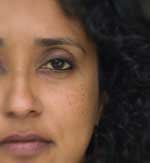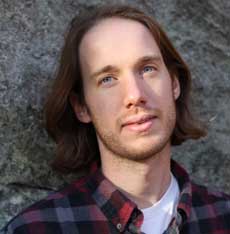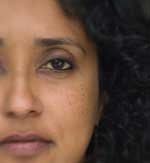Speculation swirled: Did the couple jump – or flee?
 The Emery’s dramatic end (or beginning) drew national attention and sparked haunting reenactments on Unsolved Mysteries and other TV shows. But it was left to a University of Rhode Island art and film lecturer to turn the tragedy into art.
The Emery’s dramatic end (or beginning) drew national attention and sparked haunting reenactments on Unsolved Mysteries and other TV shows. But it was left to a University of Rhode Island art and film lecturer to turn the tragedy into art.
The (unfinished) Ballad of Adam and Elena Emery is among Jacob Richman’s most compelling works, and no doubt one of the reasons he won a 2015 fellowship award from the Rhode Island Council for the Arts. Richman won in the music composition category.
Also winning a fellowship is URI photography professor Annu Palakunnathu Matthew, of Providence, whose critically acclaimed portraits challenge cultural assumptions and stereotypes. Matthew won in the new genres category.
 Richman, also of Providence, is a mixed-media composer whose work explores the relationship between sight and sound in live performance and installation settings. He uses live video, music and sound to create settings that allow performers and the audience to interact.
Richman, also of Providence, is a mixed-media composer whose work explores the relationship between sight and sound in live performance and installation settings. He uses live video, music and sound to create settings that allow performers and the audience to interact.
In the Emery piece, for instance, he used four dancers, nine musicians and a dozen rooms in the Mathewson Street United Methodist Church in Providence to recreate the killing and the folklore and conjecture that followed.
The crime is one of the most notorious in Rhode Island history. On a summer night in 1990, Adam and Elena were sitting in their Toyota Camry at Rocky Point Park in Warwick when they were side swiped by another car. Adam started chasing a car driven by 20-year-old Jason Bass, thinking he had hit him. A fight ensued, and Adam stabbed Bass through the heart with a knife he had given his wife for protection.
Paint scrapings later proved that Adam had pursued the wrong car and that Bass was innocent. In 1993, Adam was convicted of murder. Hours after the verdict, Adam, out on bail, and Elena bought black hooded sweat suits and 80 pounds of weights, ate Burger King fare and sipped wine, then drove to the Pell Bridge, where they strapped on their weights and presumably jumped. Inside the car, found later that night, were Elena’s high heels, a wallet, a purse and credit cards, all broken in half.
Nine months later, a fisherman drudged up Elena’s skull in a net. Adam was never found, leading some to wonder if he had fled on his own, perhaps to Italy, where Elena’s parents had left to find a better life. In 2004, the court issued a death certificate for Adam, although his body still has not been found.
Richman says he did a piece on the Emerys because he was “horrified and puzzled” by the crime.
“How could three people with no history of violence get involved in a situation where they could all end up dead or disappeared?” he says. “I was drawn to tragedy and the unknowableness of this story, and aimed to express that with the piece. It was also very much a Rhode Island story, and involved communities and locations around the state. Though it sounds morbid, as a new transplant to Rhode Island, researching the story and visiting and documenting these locations taught me a lot about my new home state.”
Over the years, Richman has also been busy with other work, including Go Down! You Blood Red Roses, in which a percussionist plays four instruments which are processed electronically to create the sound of a rolling sea, Ecology, a multimedia work based on a short story by Joshua Ben-Noah Carlson, and Pretty Polly, a murder ballad that traces its history back through American bluegrass repertoire to England and Scotland. He is currently working on a setting for violin and video of a short story by author and Brown University writing professor Brian Evenson.
“In my work I try to explore hidden connections between things: people, places, animals, elements, etc.,” he says. “I find that mixing media – video, music, electronics – with talented performers – musicians, dancers, actors – is a fruitful way to explore these connections.”
Richman teaches film theory in URI’s Harrington School of Communication and Media and video and multimedia production in the Art and Art History department. He graduated from Harvard and received his doctorate in music and multimedia production from Brown University.
Matthew’s work is also visionary.
Born in England and raised in India, Matthew, a professor of photography and director of URI’s Center for the Humanities, explores our multiracial and multicultural world by using photography to expose stereotyping, assimilation and legacies of America’s colonial past.
In her “An Indian from India” series at the Smithsonian National Museum of History she pairs 19th century photos of Native Americans with self-portraits that depict her dressed in clothes from India. She uses Photoshop and other tools to manipulate the imagery.
In her latest work, “Majority Minority,” Matthew is photographing several generations of immigrant families, a timely piece considering that minorities are expected to be the majority in 2050.
Matthew’s recent exhibitions include the RISD Museum, Newark Art Museum and the Guangzhou Biennial of Photography in China. An upcoming solo exhibit will be at the Royal Ontario Museum of Art in Toronto.
“Receiving a RISCA award is always an honor,” says Matthew, who also won a fellowship in 2001, 2004 and 2009. “This time is especially special for me as the definition of photography has started to blur and my work now falls between photography and video.”
Richman and Matthew are among the 25 artists honored by the arts council. All of the artists’ work will be exhibited through March 6 at the Dorrance H. Hamilton Gallery at Salve Regina University in Newport.
Fellowship writers’ night will be February 26 from 6:30 to 8:30 p.m., and an artist talk and closing reception will be March 6 from 6 to 8 p.m. Richman will discuss his work at the March 6 event. All events are free and open to the public.
The annual fellowship exhibition showcases works by Rhode Island artists who have been recognized by the state for artistic excellence. Winners receive a $5,000 award and fellowship merit award winners receive a $1,000 award.
For a video of Mathew’s work visit “Majority Minority.”. To view Richman’s work, visit “Emery Ballad.”
Pictured above:
Annu Palakunnathu Matthew, a photography professor at the University of Rhode Island.
Photo courtesy of Annu Palakunnathu Matthew.
Jacob Richman, a lecturer in art and film at the University of Rhode Island.
Photo courtesy of Jacob Richman.

